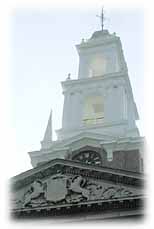 |
Who Yale HonorsBerkeley
College |
Timothy Dwight College Timothy Dwight himself purchased a slave in 1788. Furthermore, under his Yale presidency Yale produced more pro-slavery clergy than any other college in the nation. Historian Larry Tise did a study of prominent pro-slavery clergy, and where they were educated:
For students today, it may seem odd to suggest that the president could play a role shaping the ideology of Yale's graduates. In Dwight's day, however, there were few faculty other than the president. Most of the teaching was done by "tutors," often appointed for only a year or two immediately after themselves graduating from Yale. Yale's President remained the undisputed senior scholar. President Dwight in fact held the "Livingston Professorship of Divinity," at the time Yale's only endowed professorship. Dwight played a significant educational role in the students' development:
One set of these disputations was recorded and published. Dwight also published poems and collections of sermons. Throughout Dwight's writings we find a generally cavalier attitude towards American slavery mixed with vicious attacks on European slavery. When Dwight died in 1817, he had created a national institution. Dwight trained the leaders of a conservative Christian generation. Moses Stuart published a Scriptural defense of slavery in 1850. Nathaniel W. Taylor concluded student disputations at Yale with pro-slavery decisions throughout the 1840s and 1850s. Dwight also
trained a generation of administrative Yale leadership. Early in his
tenure, Dwight expanded the size of the faculty by appointing three
key professors: Benjamin Silliman, professor
of chemistry and geology; James Luce Kingsley, professor of classical
languages; and Jeremiah Day,
professor of mathematics and future Yale president."These
three men, originally with Dwight, then largely alone, ran Yale for
the first half of the nineteenth century." (83) |
|
 Under
Timothy Dwight, Yale College began its long transformation from an regional
institution training clergy to a nationally renowned institution of
higher education.
Under
Timothy Dwight, Yale College began its long transformation from an regional
institution training clergy to a nationally renowned institution of
higher education.